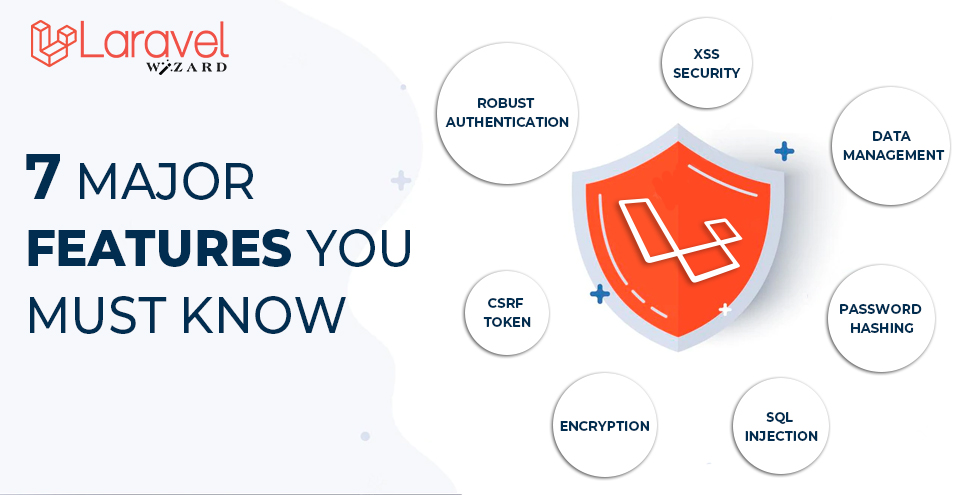
Laravel Security: 7 Major Features You Must Know
Laravel is a well-known development framework noted for its efficiency and existing user base. Even though Laravel is relatively safe, there is no such thing as a 100% secure framework. For hackers, accessing an unsecured platform is not a huge concern.
Make sure you adhere to the Laravel security best practices to reduce all security issues. Security is certainly one of the most critical factors when developing a project. As a result, this may require experience with the technology stack and Laravel security features.
The most significant security flaws and some best practices are discussed in this article.
- Laravel’s robust authentication system
Laravel’s authentication system is robust. However, Laravel hacking is a common problem that can lead to XSS and other supporting file issues. Most website hacking victims detect that their web pages being redirected to other malicious websites.
Laravel already has a solid user authentication system in place because the boilerplate code for the corresponding procedure is provided in the scaffolding. Laravel uses providers and guards to make authentication easier. Guards authenticate users for each request they make, and providers retrieve only authenticated users from the database.
The Laravel developer only needs to set up the database, controllers, and models. The software has authentication mechanisms that are implemented during the process.
- Laravel Security from Cross-Site Scripting (XSS)
The pre-installed Laravel Security Packages help to protect the system from XSS assaults. The attackers employ JavaScript codes to access the text area when this happens. The server would be vulnerable due to insufficient XSS Laravel security features, even if the submitted code isn’t entirely malicious.
As a result, whenever a new visitor loads the impacted page, JavaScript is loaded again, interfering with system security.
In this sense, the native Laravel security support includes tools for launching and securing the database. The structure then generates standard HTML from any code that has escape tags.
- Cross-Site Request Forgery (CSRF)
Cross Site Request Forgeries, also known as CSRF, is a time-tested hacker tactic whereby hackers induce a user to perform things that they do not want to. By doing so, the hacker bypasses the same-origin principle, prohibiting interference between two websites.
Laravel keeps track of all existing user sessions and generates a CSRF token for each. Laravel uses the Form Classes Token Method, which is enabled by default. The token and a built-in CSRF filter are visible in the source code.
It ensures that each request originates from your Laravel web application development and not from a prospective XSS attack by a third party. If the CSRF token detects a potentially harmful request, it returns the HTTP error code and denies permission.
- SQL Injection
Laravel’s Eloquent ORM uses PDO binding to prevent SQL injections. This feature ensures that no client can alter the SQL queries’ intent.
Laravel support offers various database communication methods, such as raw SQL queries. Nonetheless, Eloquent is the most popular option and helps prevent SQL injection attacks caused by malicious SQL queries.
- Password Hashing
Hashing is a component or algorithm that converts an item’s information to an integer value. In addition, the hash function is utilised to narrow lookups while attempting to locate these components on the data map.
Hashing reduces a string of characters to a minimal constant value or offers a key that can be used to define the original Text. Laravel’s hash function provides a secure mechanism to save passcodes in a hashed format, a more compressed version of the password storage approach.
Laravel’s hash algorithm supports Argon2 and Bcrypt hashing for storing the user’s passcode.
- End-to-end Laravel encryption
Laravel provides encryption built-in for storing and managing data within the database, such as credit card details and passwords. Moreover, the structure allows you to encrypt only certain fields of your prototype, attempting to keep such bits of data from being lost in your database.
It allows you to keep your users’ table data secure while making changes at any point. Using Laravel’s built-in validator regulations, developers can create filtration on your information. Laravel provides facilities for strong AES encryption.
- Cookies & data management
Implementing data sessions and cookies is an incredible way to ensure that end-user data is kept secure and confidential. There are various factors to keep in mind while dealing with this within Laravel.
Activate HttpOnly as a component of your app’s Laravel session. It will offer an extra layer of protection by preventing JavaScript from supporting session cookies. Set a low session inactive timeout value to redirect users to log out automatically when inactive.
Final Words
Finally, in order to help protect your Laravel application development, you must follow these Laravel security best practices.
The most crucial thing is to keep your Laravel and other software up to date, be cautious about verification safety, always filter user information, and devise a strategy for regular evaluations of your Laravel security.
Following these guidelines will help to ensure the security and privacy of your users’ information. Contact Laravel Wizard specialists for best-in-class Laravel development services if you need help with continuous improvement for your Laravel web application development and to take advantage of best-in-class digital solutions from a reliable Laravel development company. Get in touch with us today.
